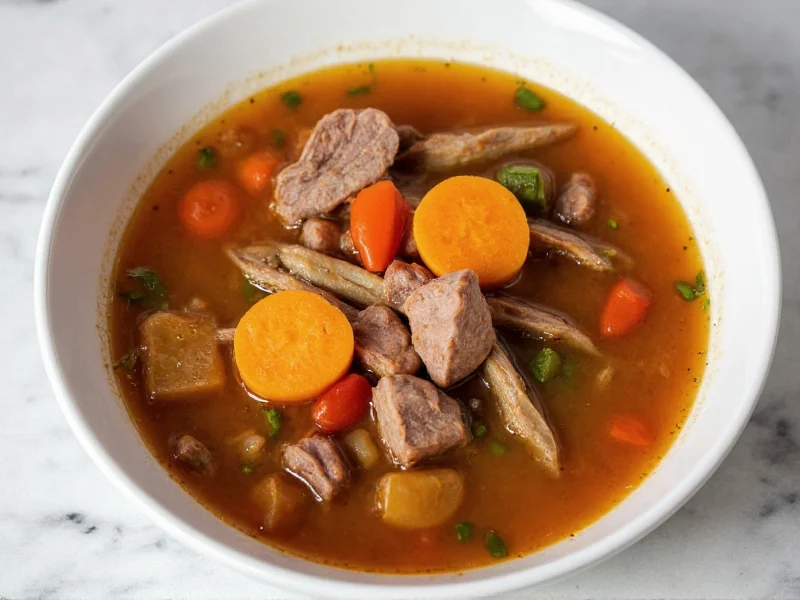For centuries, meat soup has served as both sustenance and comfort across global cultures. From French pot-au-feu to Korean seolleongtang, these broths transform humble ingredients into deeply flavorful, nutrient-dense meals. Understanding the science behind proper meat soup preparation separates adequate attempts from truly exceptional results.
The Science Behind Flavorful Meat Broth
Creating exceptional meat soup begins with understanding collagen conversion. When simmering bone-in cuts like beef shanks or chicken backs, the collagen breaks down into gelatin over time, creating that signature rich mouthfeel. This process requires maintaining a gentle simmer between 180-200°F (82-93°C) for at least 3 hours—boiling too vigorously creates cloudy broth and bitter flavors.
Professional chefs emphasize the "layering principle" for meat soup development:
| Layer | Ingredients | Function |
|---|---|---|
| Foundation | Bones, connective tissue | Provides collagen for body and richness |
| Aromatics | Onions, celery, carrots (mirepoix) | Creates flavor base through Maillard reaction |
| Flavor Enhancers | Tomato paste, mushrooms, dried shrimp | Adds umami depth and complexity |
| Finishing | Fresh herbs, citrus, vinegar | Brightens and balances final flavor profile |
Regional Meat Soup Variations Worth Mastering
Authentic meat soup preparation varies significantly by culture, each with distinctive techniques:
- French Pot-au-Feu: Requires double-straining broth and serving with cornichons and mustard for traditional presentation
- Korean Seolleongtang: Simmered for 18+ hours until broth turns milky white, traditionally served with thin rice cakes
- Turkish Iskembe Corbasi: Uses tripe and trotters, clarified with vinegar and egg yolks for distinctive texture
- Mexican Caldo: Features whole vegetables added at different stages to maintain texture integrity
Optimal Meat Selection for Different Soup Types
Choosing the right cut dramatically impacts your meat soup's final quality. Marbled cuts with connective tissue yield superior results compared to lean meats. For beef soup, oxtail provides exceptional gelatin content while shank offers balanced flavor. Chicken soup achieves best results with backs and necks rather than breast meat alone.
When preparing traditional meat broth recipes, consider these professional recommendations:
- Roast bones first for deeper flavor in brown broths
- Add acidic components like tomatoes early to help extract minerals from bones
- Skim impurities during first 30 minutes of simmering for crystal-clear broth
- Cool broth rapidly after cooking to preserve freshness and prevent bacterial growth
Avoiding Common Meat Soup Mistakes
Even experienced cooks make critical errors when preparing meat soup. Overlooking these details compromises results:
- Adding salt too early: Wait until final hour of cooking to prevent toughening meat fibers
- Boiling instead of simmering: Vigorous boiling emulsifies fat into broth, creating greasy texture
- Overcooking vegetables: Add delicate vegetables like peas or spinach in last 10 minutes
- Skipping the resting period: Allow soup to cool overnight for flavors to fully meld
Nutritional Benefits of Properly Prepared Meat Soup
Well-made meat soup delivers significant nutritional advantages beyond simple comfort. The slow simmering process extracts minerals like calcium, magnesium, and phosphorus from bones. Collagen conversion to gelatin supports joint health and improves gut lining integrity. Traditional meat soup preparation methods preserve water-soluble vitamins that might be lost in other cooking techniques.
For health-conscious preparation of homemade meat broth, consider these modifications:
- Use organic bones to minimize potential contaminants
- Add apple cider vinegar to increase mineral extraction
- Incorporate medicinal mushrooms like shiitake for immune support
- Include seaweed for additional trace minerals
Storage and Reheating Best Practices
Proper storage maintains meat soup quality for future enjoyment. Cool broth rapidly by placing pot in ice water bath before refrigerating. Store in airtight containers with minimal headspace to prevent oxidation. For extended storage, freeze in portion-sized containers with 1-inch headspace for expansion.
When reheating traditional meat soup, follow these professional guidelines:
- Thaw frozen soup in refrigerator overnight
- Reheat gently over medium-low heat without boiling
- Add fresh herbs and a splash of acid (lemon juice or vinegar) after reheating
- Skim excess fat that rises to surface during reheating
Frequently Asked Questions
How long should I simmer meat soup for optimal flavor?
For beef or lamb soups, simmer for 3-4 hours minimum to fully extract collagen. Chicken soups require 2-3 hours. Bone broths benefit from 12-24 hours of gentle simmering. The meat should easily separate from bones when properly cooked.
What's the best way to prevent cloudy meat broth?
Start with cold water and gradually bring to a simmer, never a boil. Skim impurities during the first 30 minutes. Avoid stirring once simmering begins. For crystal-clear broth, you can clarify with egg whites following traditional consommé techniques.
Can I use leftover roast meat for soup?
Yes, but add cooked meat during the final 30 minutes of preparation to prevent overcooking and texture degradation. For best results, use the bones and scraps from roasted meat to create the broth base, then add reserved cooked meat at the end.
How do I fix overly salty meat soup?
Add raw potato chunks to absorb excess salt (remove after 15-20 minutes). Dilute with unsalted broth or water. Acidic components like lemon juice or vinegar can help balance perceived saltiness. Adding sweetness from carrots or a small amount of sugar may also counterbalance saltiness.
What vegetables work best in traditional meat soup?
Classic mirepoix (onions, carrots, celery) forms the essential base. Leeks, parsnips, and turnips add depth. Add hardy vegetables like potatoes and root vegetables in the last hour. Delicate vegetables like peas, spinach, or green beans should go in the final 10-15 minutes to maintain texture.











 浙公网安备
33010002000092号
浙公网安备
33010002000092号 浙B2-20120091-4
浙B2-20120091-4